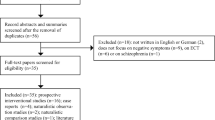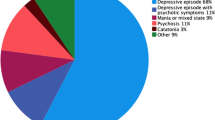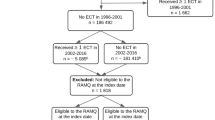Abstract
To examine disease and treatment characteristics of patients with schizophrenia treated with electroconvulsive therapy (ECT). We examined charts from 79 patients diagnosed with schizophrenia (n = 55), persistent delusional disorders (n = 7), and schizoaffective disorders (n = 17) between 2003 and 2008. We recorded age, sex, indication for ECT, number of ECT sessions, ECT series, outcome, maintenance ECT, use of antipsychotics, duration of illness, and duration of the current exacerbation. All patients were taking antipsychotics at the time of enrolment in the study. Acute ECT included 2–26 sessions; maintenance ECT (M-ECT) was given to 18 patients for up to 12 years. Initial indications for ECT included psychosis (n = 28), pronounced affective symptoms (n = 28), delirious states (n = 20), and M-ECT (n = 3). Most patients experienced excellent/good outcomes (n = 66), but others experienced moderate (n = 8) or poor (n = 5) outcomes. No factors were identified that predicted treatment responses in individual patients. ECT proved to be effective in a population of patients that were severely ill with treatment-refractory schizophrenia. This does not imply that the patients were cured from schizophrenia. Rather, it reflects the degree of relief from psychosis and disruptive behaviour, as described in the patient charts. The treatment was often offered to patients after considerable disease durations.
Similar content being viewed by others
References
Cerletti UBL (1938) Lélettroshock. archivio generale di neurologia, psichiatria e psicoanalisi 19:266–268
van Waarde JA, Verwey B, van der Mast RC (2009) Meta-analysis of initial seizure thresholds in electroconvulsive therapy. Eur Arch Psychiatry Clin Neurosci 259:467–474
Van PT, Marder SR, Mintz J (1990) A controlled dose comparison of haloperidol in newly admitted schizophrenic patients. Arch Gen Psychiatry 47:754–758
Kane JM, Honigfeld G, Singer J, Meltzer H (1988) Clozapine in treatment-resistant schizophrenics. Psychopharmacol Bull 24:62–67
Kho KH, Blansjaar BA, de VS, Babuskova D, Zwinderman AH, Linszen DH (2004) Electroconvulsive therapy for the treatment of clozapine nonresponders suffering from schizophrenia–an open label study. Eur Arch Psychiatry Clin Neurosci 254:372–379
MSCESK Caroff SN (2004) Epidemiology. In: In Caroff SN, Ge MSFAF (eds) Catatonia: from psychopathology to neurobiology. American Psychiatric Press, Washington, DC
Chanpattana W, Chakrabhand ML (2001) Combined ECT and neuroleptic therapy in treatment-refractory schizophrenia: prediction of outcome. Psychiatry Res 105:107–115
Chanpattana W, Andrade C (2006) ECT for treatment-resistant schizophrenia: a response from the far East to the UK. NICE report. J ECT 22:4–12
Painuly N, Chakrabarti S (2006) Combined use of electroconvulsive therapy and antipsychotics in schizophrenia: the Indian evidence. A review and a meta-analysis. J ECT 22:59–66
Tharyan P, Adams CE (2005) Electroconvulsive therapy for schizophrenia. Cochrane Database Syst RevCD000076
American Psychiatric Association (2001) The practice of ECT: recommendation for the treatment, training, and privileging (A Task Force Report of the American Psychiatric Association). American Psychiatric Press, Washington
Andersson JE, Bolwig TG JHA SK. [ECT behandling I Danmark.]. 1-102. 2002. Copenhagen, Danish psychiatric society
National Institute for Clinical Excellence. Guidance on the Use of Electroconvulsive Therapy (2003) London, National Institute for Clinical Excellence (NICE). Technology Appraisal 59
Munk-Jorgensen P, Kastrup M, Mortensen PB (1993) The Danish psychiatric register as a tool in epidemiology. Acta Psychiatr Scand Suppl 370:27–32
Nothdurfter C, Eser D, Schule C, Zwanzger P, Marcuse A, Noack I, Moller HJ, Rupprecht R, Baghai TC (2006) The influence of concomitant neuroleptic medication on safety, tolerability and clinical effectiveness of electroconvulsive therapy. World J Biol Psychiatry 7:162–170
Guy W (2008) Clinical global impressions scale. In: Rush JABD (ed) Handbook of psychiatric measures. American Psychiatric publishing, Washington, DC, pp 90–92
Bauer J, Hageman I, Dam H, Baez A, Bolwig T, Roed J, Olsen NV, Jorgensen MB (2009) Comparison of propofol and thiopental as anesthetic agents for electroconvulsive therapy: a randomized, blinded comparison of seizure duration, stimulus charge, clinical effect, and cognitive side effects. J ECT 25:85–90
American Psychiatric Association (1994) Diagnostic and statistical manual of mental disorders: DSM-IV. American Psychiatric Press, Washington, DC
Braga RJ, Petrides G (2005) The combined use of electroconvulsive therapy and antipsychotics in patients with schizophrenia. J ECT 21:75–83
Tang WK, Ungvari GS (2003) Efficacy of electroconvulsive therapy in treatment-resistant schizophrenia: a prospective open trial. Prog Neuropsychopharmacol Biol Psychiatry 27:373–379
Ucok A, Cakr S (2006) Electroconvulsive therapy in first-episode schizophrenia. J ECT 22:38–42
Chanpattana W, Sackeim HA (2010) Electroconvulsive therapy in treatment-resistant schizophrenia: prediction of response and the nature of symptomatic improvement. J ECT 26(4):289–298
Damm J, Eser D, Schule C, Obermeier M, Moeller HJ, Rupprecht R, Baghai TC (2010) Influence of age on effectiveness and tolerability of electroconvulsive therapy. J ECT 26(4):282–288
The UK ECT Review Group (2003) Efficacy and safety of electroconvulsive therapy in depressive disorders: a systematic review and meta-analysis. Lancet 361:799–808
Dodwell D, Goldberg D (1989) A study of factors associated with response to electroconvulsive therapy in patients with schizophrenic symptoms. Br J Psychiatry 154:635–639
Miller CE, Sharif ZA (1998) Efficacy of ECT in chronic aggressive behavior in schizophrenic/schizoaffective disorder inpatients. Schizophr Res 29:163
Stromgren LS (1997) ECT in acute delirium and related clinical states. Convuls Ther 13:10–17
Fink M, Taylor MA (2001) The many varieties of catatonia. Eur Arch Psychiatry Clin Neurosci 251(1):I8–I13
Chanpattana W, Kramer BA (2003) Acute and maintenance ECT with flupenthixol in refractory schizophrenia: sustained improvements in psychopathology, quality of life, and social outcomes. Schizophr Res 63:189–193
Shimizu E, Imai M, Fujisaki M, Shinoda N, Handa S, Watanabe H, Nakazato M, Hashimoto K, Iyo M (2007) Maintenance electroconvulsive therapy (ECT) for treatment-resistant disorganized schizophrenia. Prog Neuropsychopharmacol Biol Psychiatry 31:571–573
Suzuki K, Awata S, Takano T, Ebina Y, Iwasaki H, Matsuoka H (2005) Continuation electroconvulsive therapy for relapse prevention in middle-aged and elderly patients with intractable catatonic schizophrenia. Psychiatry Clin Neurosci 59:481–489
Swoboda E, Conca A, Konig P, Waanders R, Hansen M (2001) Maintenance electroconvulsive therapy in affective and schizoaffective disorder. Neuropsychobiology 43:23–28
Levy-Rueff M, Jurgens A, Loo H, Olie JP, Amado I (2008) Maintenance electroconvulsive therapy and treatment of refractory schizophrenia. Encephale 34:526–533
Wustmann T, Pillmann F, Marneros A (2010) Gender-related features of persistent delusional disorders. Eur Arch Psychiatry Clin Neurosci [Epub ahead of print]
Acknowledgments
Thanks to Linda Lund Schou and Helen G Nielsen for valuable secretary assistance.
Conflicts of interest
The authors report no conflicts of interest.
Author information
Authors and Affiliations
Corresponding author
Rights and permissions
About this article
Cite this article
Kristensen, D., Bauer, J., Hageman, I. et al. Electroconvulsive therapy for treating schizophrenia: a chart review of patients from two catchment areas. Eur Arch Psychiatry Clin Neurosci 261, 425–432 (2011). https://doi.org/10.1007/s00406-010-0173-3
Received:
Accepted:
Published:
Issue Date:
DOI: https://doi.org/10.1007/s00406-010-0173-3




